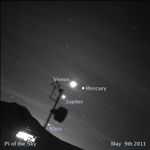News /
Nature: Discovery of lonely planets - Polish + NZ-JP-USA astronomers [4]
Today's dailies confusingly report an astronomical discovery of a lonely planet/lonely planets - as if it just happened yesterday. But actually they refer to a scientific letter sent to Nature, which summarizes discovery of 12 such lonely planets during the last two years by two cooperating teams: Polish and NZ-Japanese-American.
Discovery of extrasolar planets freely moving in space
An international team of astronomers with the participation of Poles discovered a new class of extrasolar planets - Jupiter mass objects moving freely in space.
The discovery is described in the latest issue of the prestigious journal Nature. The research team, who made the discovery, consists of two groups involved in the study of gravitational microlensing: Polish astronomers from OGLE project of the University of Warsaw and the Japan-New Zealand team from the project MOA.
OGLE project is run by the Warsaw University Astronomical Observatory since 1992. The current phase of the OGLE-IV was launched in March 2010. This is a new generation sky survey, discovering many more microlensing events than the previous surveys.
(...)
nauka.gov.pl/nauka/sukcesy-uczonych/sukcesy-uczonych/artykul/odkryto-swobodnie-poruszajace-sie-planety-pozasloneczne/
Many lonely planets
The Milky Way is teeming with planets that do not revolve around a star.
In German: astronomie.scienceticker.info/2011/05/18/viele-einsame-planeten/
Lonely Planet ejected out of solar system
These are probably the objects, which in the early stages of evolution of planetary systems have been ejected by the gravitational forces and they now freely roam the galaxy - said prof. Andrzej Udalski of Warsaw University Astronomical Observatory.
A star becoming a lens
The discovery of the so-called free planet has been made by two cooperating groups of scientists: Polish fOGLE (Optical Gravitational Lensing Experiment) team directed by prof. Udalski and New Zealander-Japanese-American group of MOA project (Microlensing Observations in Astrophysics). The researchers describe their discovery in today's issue of the journal Nature.
(...)
rp.pl/artykul/660539_Planety_wyrzucone_za_uklady.html
You can read a part of this article in Nature here:
Since 1995, more than 500 exoplanets have been detected using different techniques[] of which 12 were detected with gravitational microlensing[]. Most of these are gravitationally bound to their host stars. There is some evidence of free-floating planetary-mass objects in young star-forming regions[], but these objects are limited to massive objects of 3 to 15 Jupiter masses with large uncertainties in photometric mass estimates and their abundance. Here, we report the discovery of a population of unbound or distant Jupiter-mass objects, which are almost twice ( ) as common as main-sequence stars, based on two years of gravitational microlensing survey observations towards the Galactic Bulge. These planetary-mass objects have no host stars that can be detected within about ten astronomical units by gravitational microlensing. However, a comparison with constraints from direct imaging[] suggests that most of these planetary-mass objects are not bound to any host star. An abrupt change in the mass function at about one Jupiter mass favours the idea that their formation process is different from that of stars and brown dwarfs. They may have formed in proto-planetary disks and subsequently scattered into unbound or very distant orbits.
nature.com/nature/journal/v473/n7347/full/nature10092.html
To access full article you would have to pay $32
See also:
MOA, Microlensing Observations in Astrophysics, phys.canterbury.ac.nz/moa/
OGLE, Optical Gravitational Lensing Experiment, ogle.astrouw.edu.pl/
Microlensing exoplanets, scholarpedia.org/article/Microlensing_exoplanets
The Extrasolar Planets Encyclopaedia, exoplanet.eu/catalog-microlensing.php
 PolishForums LIVE / Archives [3]
PolishForums LIVE / Archives [3]

